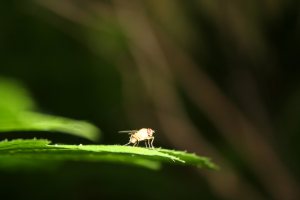Strawberries in the garden
15.8 years ago indoor growbox, strawberries
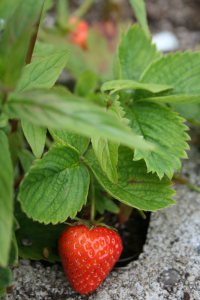
Strawberries thrive here in the Pacific Northwest but this year the June bearers almost missed their month this year with some of the erratic weather we have had during the past couple months. Last year I planted about a half dozen June bearing plants in the holes of the cinder blocks that surround my raised bed. We got enough strawberries to keep our oldest daughter satisfied for an occasional snack but still had to supplement from the grocery store to satisfy her strawberry habit and with the rising produce prices I let the let some of the runners spread to their neighboring cinder block holes and some cases transplanting the start to a more appropriate location. A couple months ago I also planted some different varieties of Everbearing strawberries to provide fruit throughout more of the summer.
The normal life cycle of a strawberry plant is 3 years. The first year will consist of plant growth where you should see a decent number of strawberries but not as much as the second year. My second year plants are about a foot tall and have dozens of large strawberries growing on them. I have been cutting any runners that shoot out to allow the plant to spend its energy on those delicious berries. The third year the plant’s production will be less and will be spending more of its energy on its runners which is a good time to let those runners turn into new plants and let the cycle repeat. After the plants have finished producing this is the time to fertilize with a balanced fertilizer (10-10-10) otherwise this can lead to excessive leaf growth and less production. Fertilizing at this time will also give the plants the chance to store some much needed energy over the cold winter and have a good head start for the following spring.
Now this morning my oldest daughter was tired of picking strawberries sure it had nothing to do with her picking two and a half pounds of strawberries at Harvold Berry Farm the day before.
Tags: cheap, outdoor plants, strawberry plants, vegetables
Make your own cheap butterfly feeder
15.9 years ago butterfly, butterfly feeder, butterfly garden
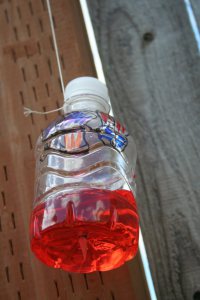
As the days are getting longer (happy first day of summer) it is actually starting to get a little warmer even here in the Pacific Northwest so decided it would be a good time to add our homemade butterfly feeder to our butterfly garden, but first we actually had to make it.
If you want to make your own here is all you need:
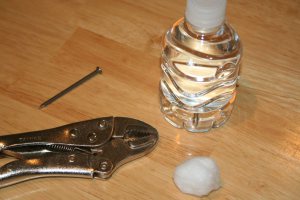
– Plastic/glass container (baby jar, water bottle, etc)
– Nail
– Pliers
– Lighter (not pictured)
– Cotton or sponge
Steps to have your own buttery feeder in your garden:
1. Heat up nail with lighter (or candle) using pliers to avoid pain on your fingers.
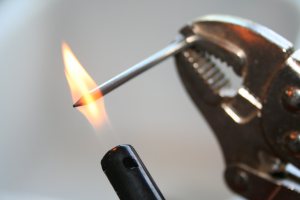
2. Use hot nail to burn a hole through the plastic.
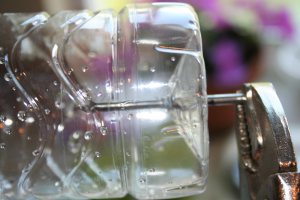
3. Stuff some cotton (swab, ball, shirt) or a piece of sponge in the hole and tight as possible.
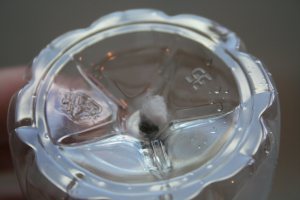
4. Decorate with markers (make sure to have some red) plastic flowers etc (Optional but funnier for the kids)
5. Fill with some butterfly nectar (recipe below) and hang by some of your colorful flowers
Butterfly/Hummingbird Nectar
Ingredients:
¼ cup of sugar
1 cup of water
3 drops of red food coloring [optional]
Directions:
Add sugar and water to water bottle and shake. If you are using raw organic sugar bring water to boil and mix in sugar. Butterfly nectar is good for 2-3 weeks and water in feeder should be replaced a 3-4 days.
Does this all seem like too much work? Well you can also simply place over ripened fruit (bananas, apples, peaches, orange slices, etc) on a plate and your butterflies will love it.
Read Other Butterfly Garden Posts
Tags: butterfly garden, cheap, organic vegetables, vegetables
Blog for the not so beautiful things out there
15.9 years ago birds, potatoes, slugs
I see many blogs showing pictures of pretty flowers and cute little animals, when I was going on a nature hike today with my youngest daughter I came across some things that were interesting but not exactly beautiful which deserved some recognition.
If I saw this guy in my garden I probably wouldn’t be an inclined to stop and take his picture.
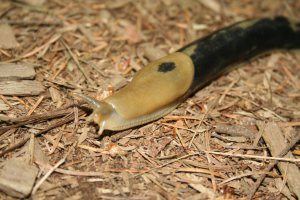
Well potatoes are not that pretty so guess I wouldn’t expect the flowers to look much better
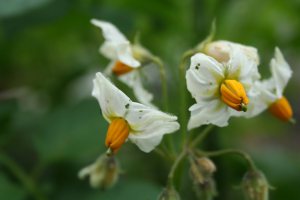
Tags: birds, cheap, vegetables
Where did the tomatoes go?
15.9 years ago salmonella, tomato
I have to admit I am not that great about keeping up with my current events, so if it is not in Engadget or my various gardening RSS feeds I haven’t heard about it. So after the second day I noticing the lack of tomatoes in the cafeteria at work I had to investigate. For anyone who watches the news or reads a newspaper apparently there was a widespread outbreak of salmonella in raw red plum, red Roma and round red tomatoes with reports in almost every state in the US according to the FDA.
If you have been thinking about growing your own tomatoes (or any other produce) and the thought of having a constant supply of fresh produce in your backyard, better taste, more selection, and increased prices for produce was not enough for you to start. Now you can add safety can be added to the list with the reassurance that you know exactly what has gone into the soil of the food you are eating.
Tags: cheap, tomato plants, vegetables
Slugs eating my garlic
15.9 years ago garlic bulbs, slugs
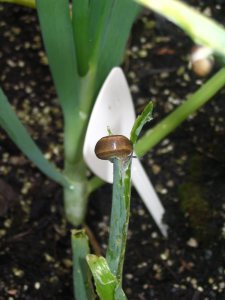
The word is slugs are supposed to hate garlic, guess no one told this guy. The reality is they do not like the bulb underground apparently the garlic leaves are delicious. Appears that I need to step up my war with the slugs.
Tags: cheap, garlic bulbs, vegetables
Planting mint in your garden
15.9 years ago mint, peppermint
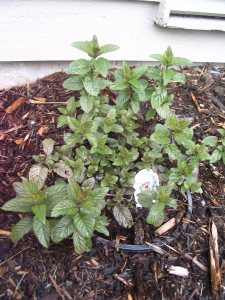
If you happen to have a couple of brown thumbs and kill any plant you touch you may want to consider planting mint in your garden. These members of the mint family is so hardy that it can practically be planted anywhere and in many cases it can take over your garden without taking some precautions during your planting. Couple of low impact options is to grow it in a pot on your patio or even grow in a hanging basket and harvest the leaves as they grow over the side. If you wish to grow your mint at ground level you will need to create a root barrier to keep it from spreading over your whole garden. You start by digging a 12-18 inch hole and place your mint in a large plastic pot or lay down a plastic liner with drainage holes. One other option is to use an old 5 gallon bucket and give your mint a little more room to grow but you will need to dig a little deeper hole.
Now for picking your plant(s), if you want some peppermint for tea or that mojito in the middle of summer you will need to buy your plant from a nursery (unless you have a nice friend or neighbor to get a start from them) since peppermint is sterile so you will be unable to grow it from seed. Other mints such as spearmint can be started from seed but it will take a couple months until you can begin harvesting. I would definitely recommend buying as plants since they are usually inexpensive and a modest plant can become pretty established in just a few weeks. The one exception is if you want a species you may not be able to find in your area nursery, so seeds might be your only option.
So why grow mint in the first place. It has a great fragrance and many uses including refreshing your breath, deterring pests (mosquitoes, slugs, wasps, and ants), garnishes or major ingredient to your cold drinks. For me the primary reason was peppermint tea.
If you don’t think you like peppermint tea make sure you try the fresh version before you sign it off. Tea leaves are dried so they last longer if you want the best flavor best to use it fresh. There is no part of peppermint that can harm you so can break off a piece of mint (stem and all) and let it seep for 5 to 10 minutes. Not only is it a refreshing beverage that leaves your mouth with a nice clean taste but also can help with any stomach discomfort. If you want something with a little more flavor try this recipe:
Straight from the garden peppermint tea recipe
Ingredients:
- 3 peppermint leaves
- 3 spearmint leaves
- 3 lemon balm leaves
Directions:
Add leaves to one cup of boiling hot water. Let leaves seep for 10 minutes. Add honey or sugar if desired.
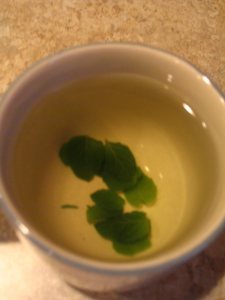
Tags: cheap, garden seeds, outdoor plants, pepper plants, peppermint plant, vegetables
